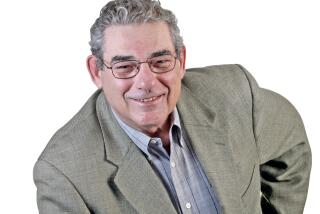Commentary : Times Edition Left Mark on City’s Media : Newspapers: When it closes Friday, the San Diego County Edition of The Times ends 15 years of zealously enlarging the news agenda as the city grew to adulthood.
- Share via
An old Mac Davis song has it that life often is “too much gin and not enough vermouth.”
For me and perhaps other San Diegans, it may seem just a little more so after Friday. That’s when The Times puts out the last issue of a San Diego County Edition and ends an interesting experiment. (While the customized version for San Diego will end, standard Los Angeles Times product will continue to be delivered and sold in San Diego County.)
No other metropolitan newspaper has ever published a localized daily edition 120 miles from its home base.
But this experiment came to clash with the stark economic realities of the early 1990s. The recession, mated with mergers and bankruptcies and takeovers among large advertisers, made 1992 the worst year for newspapers since the Depression.
On the streets of San Diego alone, the number of daily newspaper reporters will probably drop this calendar year by one-third because of the merging of the Union-Tribune and the scaling down by The Times from nearly 30 reporters to 4. To be sure, not everyone will think that’s a terrible blow to the community. But I, and I hope many others, do.
It is a particularly poignant turn of events for me. I’ve been The Times’ San Diego editor since the very first day in early 1978 when, arriving ahead of the final construction crews and carpet layers, we sat on rickety chairs at hand-me-down desks and pounded on manual typewriters, raising the concrete dust in little puffs all around us.
But pound we did. We were off and running, soon to witness the then-worst air disaster in American history and a succession of big stories coming out of this interesting, complex, beguiling corner of the world. Sagon Penn. Roger Hedgecock. Sy Murray. The San Ysidro massacre. J. David Dominelli. Sewage spills. America’s Cup. Betty Broderick. Henry Hubbard. Building booms and slow-growth campaigns. Illegal immigration and maquiladoras. The death of the tuna industry, the birth of biotech. The list is endless.
What did we accomplish? In the world of daily journalism, where even the best story dies like a snake with the setting of the sun, such appraisals are difficult. Opinions are many, certitudes are few.
But for whatever it’s worth, I think that our being here has lent a certain zest to daily journalism in San Diego, whether it be print or electronic. I think the pre-1978 journalism in San Diego was more relaxed than now, with more sacred cows honored and fewer tough questions asked. But as San Diego achieved urban adulthood, so too did its press corps--for better or for worse.
Second, I think The Times helped enlarge the news agenda, both in subjects chosen and how those stories were handled. Our newspaper became particularly well known for in-depth articles on the border, social problems, law-enforcement issues, and politics. The pieces themselves, we like to think, were objective, thorough reports. But no doubt their frequency, prominence and length also made a statement about the importance of the subject areas.
Third, on our Opinion Page, we probably were more critical of certain elected officials, less trusting of the old ways of running San Diego, more inclined to endorse candidates from both major parties, and perhaps more ecumenical in the variety of views being put forth in our commentaries. And, fourth, by reporting vigorously from San Diego for the nation’s largest metropolitan newspaper, we sent word of San Diego’s triumphs and troubles to the region, the state, and the nation. In that sense, I think we may have served as a deterrent to parochialism.
For me, it’s been 15 years working for one of the world’s great newspapers in one of America’s most beautiful cities. It’s been a chance to see that city come of age, to grapple with its own sense of self. It’s been a chance to have a box seat for some of the most interesting, tumultuous changes in California and to watch journalists, at The Times and elsewhere, earnestly seek to reflect those changes, elusive and momentous as they are.
It seems a shame, both for The Times and the community, that the curtain is falling on the San Diego County Edition. But I take some solace in concluding that the closure is an economic judgment, not a journalistic one.
More to Read
Sign up for Essential California
The most important California stories and recommendations in your inbox every morning.
You may occasionally receive promotional content from the Los Angeles Times.










